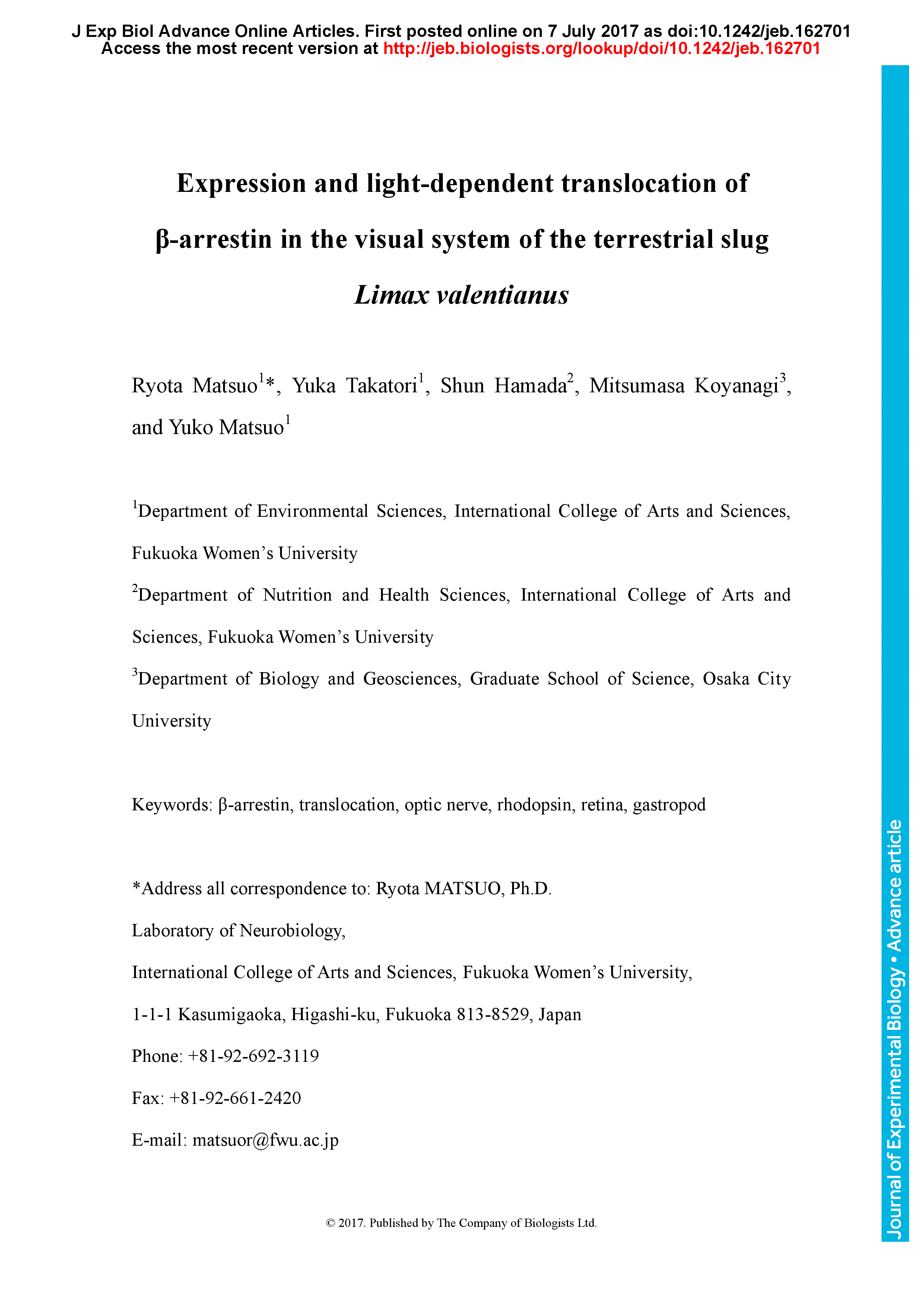Vertebrates, cephalopods, and arthropods are equipped with eyes having the highest spatiotemporal resolution among the animal phyla. In parallel, it is only the animals in these three phyla that have visual arrestin specialized for the termination of visual signaling triggered by opsin, in addition to ubiquitously expressed β-arrestin that serves in terminating general G protein-coupled receptor signaling. Indeed, visual arrestin in Drosophila and rodents translocates to the opsin-rich subcellular region in response to light to reduce the overall sensitivity of photoreceptors in an illuminated environment (i.e. light adaptation). We thus hypothesized that visual arrestin has taken over the role of β-arrestin in those animals having an eye with high spatiotemporal resolution during evolution. If this is true, it is expected that β-arrestin plays a role similar to visual arrestin in those animals having low resolution eyes. In the present study, we focused on the terrestrial mollusk Limax, a species related to cephalopods but has only β-arrestin, and generated antibody against β-arrestin. We found that β-arrestin is highly expressed in photosensory neurons, and translocates into the microvilli of the rhabdomere within 30 min in response to short wavelength light (400 nm), to which the eye of Limax exhibits a robust response. These observations suggest that β-arrestin functions in the visual system of those animals that do not have visual arrestin. We also exploited anti-β-arrestin antibody to visualize the optic nerve projecting to the brain, and demonstrated its usefulness for tracing a visual ascending pathway.
Expression and light-dependent translocation of β-arrestin in the visual system of the terrestrial slug Limax valentianus
Currently Viewing Accepted Manuscript - Newer Version Available
Ryota Matsuo, Yuka Takatori, Shun Hamada, Mitsumasa Koyanagi, Yuko Matsuo; Expression and light-dependent translocation of β-arrestin in the visual system of the terrestrial slug Limax valentianus. J Exp Biol 2017; jeb.162701. doi: https://doi.org/10.1242/jeb.162701
Download citation file:
Advertisement
2023 JEB Outstanding Paper Prize shortlist and winner

The JEB Editors are delighted to announce the shortlisted authors for the 2023 JEB Outstanding Paper Prize. Read the winning paper - Tiny spies: mosquito antennae are sensitive sensors for eavesdropping on frog calls - by Hoover Pantoja-Sanchez and Brian Leavell from Ximena Bernal's lab at Purdue University, USA.
JEB Science Communication Workshop for ECRs

If you’re an early-career researcher interested in science communication and are attending the SEB Annual Conference in Prague this summer, come a day early and join the JEB Editors at a sci comm workshop to learn the key writing skills needed to promote your research to a broad audience beyond your peers (1 July at 14.30-17.30). Places are limited to 24 attendees, and applicants should apply through the SEB registration page by 30 April 2024.
Bridging the gap between controlled conditions and natural habitats in understanding behaviour

Novel technologies enable behavioural experiments with non-model species, in naturalistic habitats and with underexplored behaviours. In their Commentary, Scholz and colleagues discuss how to obtain a deeper understanding of the natural ecology and lifestyle of study animals.
Beluga metabolic measures could help save species

To help save animals from extinction, it’s important to understand what each species needs to survive. This led Jason John et al. to measure the metabolic rates of captive belugas to develop a ‘fish calculator’ showing that the whales need to eat ~23 salmon per day.
ECR Workshop on Positive Peer Review

Are you an ECR looking for tips on how to write concise, astute and useful manuscript reviews? If so, join the JEB Editors at a 2-hour JEB-sponsored Workshop on Positive Peer Review at the Canadian Society of Zoologists annual meeting in Moncton on 9 May 2024 at 13.00-15.00. There are 25 spaces for ECRs and selection is first come, first serve. To sign up, check the ECR Workshop box when you register for the CSZ meeting.



